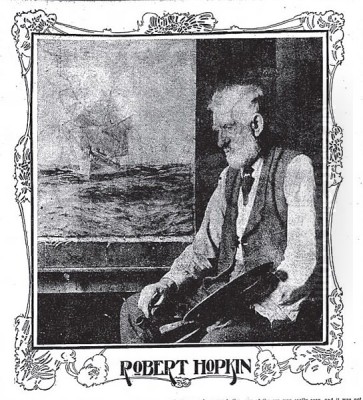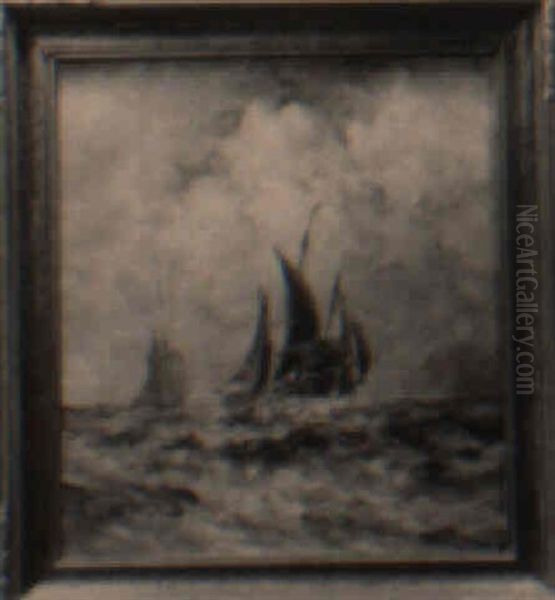Introduction: A Pillar of Detroit's Art Scene

Robert Hopkin stands as a significant figure in the history of American art, particularly within the context of Detroit, Michigan, during the latter half of the 19th and the dawn of the 20th century. Born in Scotland but intrinsically linked to the burgeoning city on the Great Lakes, Hopkin carved a unique path as a largely self-taught artist. His legacy is built upon evocative marine paintings, detailed landscapes, and a foundational role in cultivating Detroit's artistic community. Despite lacking formal academic training, his dedication and innate talent propelled him to become one of the city's most celebrated painters, leaving behind a substantial body of work and an enduring influence.
From Glasgow to the Great Lakes: Early Life and Artistic Beginnings
Robert Hopkin's journey began in Glasgow, Scotland, where he was born on January 3, 1832. The industrial heartland of Scotland perhaps offered early, albeit unrecorded, visual stimuli, but his artistic destiny would unfold across the Atlantic. In 1843, at the age of eleven, Hopkin emigrated with his parents to the United States, settling in Detroit, Michigan. This move placed the young Hopkin in a city that, while growing, lacked the established art academies and formal training opportunities found in older East Coast cities or Europe.
This environment, however, did not deter Hopkin's burgeoning passion for art. Faced with limited resources for artistic instruction, he embarked on a path of self-education. Through keen observation of the natural world, diligent practice, and an unwavering commitment to mastering his craft, Hopkin developed his skills independently. This self-reliance became a hallmark of his career, demonstrating a resilience and determination that would serve him well throughout his life. His early years in Detroit were formative, shaping his perspective and providing the subjects that would dominate his artistic output.
The Development of a Distinctive Style: Realism and the Natural World

Robert Hopkin's artistic style is firmly rooted in the traditions of Realism and Naturalism that were prominent during the 19th century. Lacking formal instruction meant he was less influenced by prevailing academic trends and more by direct observation. He developed a keen eye for detail, meticulously rendering the textures of water, the play of light on sails, the structure of ships, and the atmospheric conditions of the landscapes he depicted. His commitment was to representing the world around him with accuracy and honesty.
His paintings, whether in oil or watercolor, often showcase a remarkable ability to capture the mood and atmosphere of a scene. Light plays a crucial role in his work, whether it's the dramatic illumination of a storm-tossed vessel, the gentle glow of dawn over a calm lake, or the dappled sunlight filtering through trees in a landscape. His brushwork, while detailed, often retained a certain vigor, conveying the dynamic forces of nature, particularly in his marine subjects. This blend of detailed observation and atmospheric sensitivity defined his unique artistic voice.
Master of Marine Painting: Capturing the Spirit of the Great Lakes
While Hopkin's talents extended to landscapes and other subjects, he is perhaps best remembered and celebrated for his marine paintings, particularly those depicting the Great Lakes. Living in Detroit provided him with constant exposure to the bustling maritime activity on the Detroit River and nearby lakes like Erie, St. Clair, and Huron. These vast bodies of freshwater, with their unique character, powerful storms, and vital role in commerce, became his most enduring muse.
Hopkin painted the lakes in all their moods: tranquil dawns with mist rising from the water, busy harbors filled with schooners and early steamships, and dramatic tempests testing the resilience of vessels and sailors. He possessed an intimate understanding of ship construction and rigging, rendering vessels with technical accuracy. More than just depictions of boats, his marine works capture the relationship between humanity and the often-unforgiving power of nature, reflecting the lifeblood of the region's economy and the inherent dangers faced by those who sailed the inland seas.
Broadening Horizons: Landscapes, Decorative Arts, and Historical Scenes
Robert Hopkin's artistic interests were not confined solely to marine subjects. He was also an accomplished landscape painter. His travels took him to regions like the White Mountains of New Hampshire, a popular destination for American landscape artists, where he captured the rugged beauty of the peaks and valleys. These works demonstrate his versatility and his consistent ability to render natural scenery with sensitivity and skill. Animal painting was another area he explored, though it forms a smaller part of his known oeuvre.
Furthermore, Hopkin applied his talents to decorative painting, a field that brought his art into public and commercial spaces. His most notable commissions included creating decorative schemes and murals for the interior of the Detroit Opera House, completed in 1869. He also undertook a significant commission for the New Orleans Cotton Exchange in 1883, demonstrating that his reputation extended beyond Michigan. Additionally, Hopkin engaged with historical subjects, painting scenes related to Detroit's Civil War military units and creating a banner for the city's participation in a major exposition in 1901, likely the Pan-American Exposition.
The Chicago Interlude: Setback and Resilience
Hopkin's connection to Detroit was profound, but his career path included a significant, albeit challenging, period in Chicago. Attracted by the opportunities in the rapidly growing metropolis, Hopkin moved there, likely seeking a larger market for his work. His talent continued to gain recognition, and he attracted collectors in the city. However, this chapter of his life was dramatically interrupted by the Great Chicago Fire of 1871.
The devastating fire swept through the city, consuming vast areas and destroying countless homes and businesses. Hopkin was among those who suffered catastrophic losses. According to accounts, the fire claimed nearly all his possessions, including presumably artworks and studio materials, leaving him with little more than "his health and a few clothes." This immense setback forced him to reassess his situation. Ultimately, Hopkin and his family made the decision to return to Detroit, the city that had been his home for decades. This event, while tragic, underscores his resilience as he rebuilt his career back in Michigan.
A Founding Father: Shaping Detroit's Art Community
Upon his return and throughout his career in Detroit, Robert Hopkin played a pivotal role not just as a painter, but as a community builder within the city's nascent art scene. Recognizing the need for organization and mutual support among artists, he was instrumental in the founding of several key institutions that would nurture artistic talent and appreciation in Detroit for generations.
In 1874, he was involved in establishing the Detroit Art Association. Later, in 1882, he helped found the Art Club. Perhaps his most enduring organizational legacy is his role in the creation of the Scarab Club in 1907. This artists' society was initially named the "Hopkin Club" in his honor, a testament to his esteemed position among his peers. These organizations provided crucial platforms for exhibitions, education, and camaraderie among artists and art patrons, fostering a more vibrant cultural environment in the city. His tireless efforts in promoting the arts earned him the affectionate and respectful title "Father of Detroit Art."
Notable Works and Artistic Output
Robert Hopkin was a prolific artist, credited with producing over 390 works during his lifetime, encompassing oils, watercolors, and possibly lithographs. While a comprehensive catalogue remains a subject for art historians, several works and commissions stand out. His large-scale decorative paintings for the Detroit Opera House (1869) and the New Orleans Cotton Exchange (1883) were significant public achievements, showcasing his ability to work on an ambitious scale.
His marine paintings of the Great Lakes remain his signature contribution. While often titled descriptively (e.g., "Great Lakes Marine Scene"), some specific titles attributed to him give a flavor of his subject matter: "The Three Bells," "Columbus in Sight of Land" (suggesting a historical marine interest), "Morning," "Fixing the Nets," "Vessel Running in a Gale," "Fishing Boats," "Early Morning," and "The Pilot." Landscape titles like "Castle Kilchurn" and "On Loch Awe" likely reflect his Scottish heritage or travels. These works, held in various museums and private collections, particularly in the Midwest, attest to his skill and thematic focus.
Artistic Context and Contemporaries
Robert Hopkin's career unfolded during a dynamic period in American art. While he operated primarily within Detroit, his work aligns with broader national trends of Realism and Naturalism. His focus on marine subjects places him in a lineage of American maritime painters, though his Great Lakes focus distinguishes him from East Coast contemporaries like Winslow Homer (1836-1910) or Fitz Henry Lane (1804-1865), who primarily depicted the Atlantic coast. His landscape work resonates with the spirit, if not always the direct style, of the later Hudson River School artists such as Albert Bierstadt (1830-1902) or Frederic Edwin Church (1826-1900), who sought to capture the grandeur of the American wilderness, though Hopkin's settings were often more localized.
While the provided sources indicate a lack of specific documented records of direct, close collaborations with named Detroit contemporaries, his central role in founding art organizations implies significant interaction within that community. His influence was foundational. The Scarab Club, which he helped establish, would go on to host or feature works by major 20th-century artists, including Diego Rivera (1886-1957), Pablo Picasso (1881-1973), and the American realist John Sloan (1871-1951), demonstrating the lasting importance of the institutions Hopkin helped create. Other major American artists active during Hopkin's mature period included figures like Thomas Eakins (1844-1916), James McNeill Whistler (1834-1903), John Singer Sargent (1856-1925), and Mary Cassatt (1844-1926), representing the diverse artistic landscape of the era.
Legacy and Conclusion
Robert Hopkin passed away in Detroit in 1909 at the age of 76, leaving behind a rich legacy. His most significant contribution lies in his dedicated and skillful portrayal of the Great Lakes, capturing the unique character, maritime life, and atmospheric beauty of America's inland seas during a period of significant transformation. As a largely self-taught artist who achieved considerable success and recognition, his life story serves as an inspiration, embodying perseverance and passion.
Beyond his own canvases, Hopkin's enduring impact is felt through his foundational work in establishing Detroit's key art institutions. The title "Father of Detroit Art" is not merely honorary; it reflects his tangible contributions to building a supportive infrastructure for the arts in the city. His paintings continue to be appreciated for their historical value, their artistic merit, and their evocative depiction of a specific time and place in American history. Robert Hopkin remains a crucial figure for understanding the development of art in the American Midwest and the enduring allure of the Great Lakes.